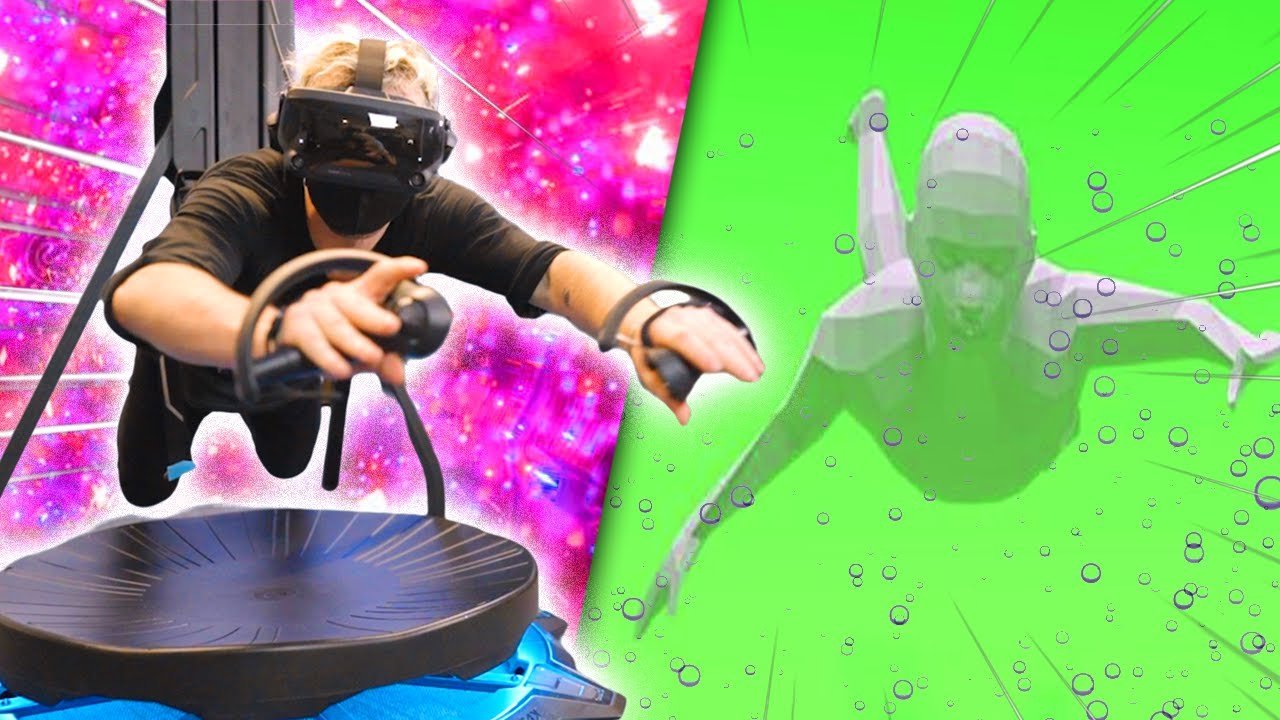An Immersive Experience
Virtual reality treadmills are the future of VR and are going to be wild. Once you take a spin on one of these rad treadmills, you’ll never want to go back to sitting on the couch when exploring virtual worlds. Strap on that headset and you’re not just seeing a virtual world, you’re walking and running through it.
Table of Contents
Tricking Your Brain
This crazy contraption lets your feet move in the real world while your avatar does the same in the virtual one. It’s like your brain gets tricked into thinking you’re hiking mountain trails or strolling down city streets when really you’re hustling on a treadmill in your living room. With these babies, VR goes from passive to active and immersive.
Mind-Blowing Technology
Trust us, this is going to blow your mind – no more getting dizzy or bumping into furniture. You’re gonna feel like you’re really there. Get ready to take VR to the next level!
The Benefits of Exercising With Virtual Reality Treadmills
Virtual reality treadmills transport you to scenic destinations around the world without ever leaving home. As you walk or run in place, high-definition displays and surround sound place you right in the middle of exotic locations or fantastical worlds. While providing an escape from everyday life, VR treadmills also offer various health benefits.
Full Body Workout
Unlike regular treadmills that only provide a cardiovascular workout, VR treadmills engage your whole body. As you explore virtual worlds, you’ll find yourself walking, jogging, running, even jumping or squatting. This dynamic movement works your legs, core, and glutes. Some VR treadmill experiences are also designed to improve balance, flexibility and strength.
Motivation to Exercise
The immersive experiences of VR treadmills make exercise fun and exciting. You’ll be so engaged in the virtual environments that you’ll barely notice the physical exertion. This can help motivate those who normally don’t enjoy working out. The variety of virtual destinations also provides ongoing incentive to get back on the treadmill. You’ll always have a new place to explore.
Stress Reduction
Exercise releases feel-good hormones called endorphins that act as natural painkillers and mood boosters. Combine this with the relaxing, rejuvenating environments of VR, and you have a powerful antidote for stress and anxiety. Walking through peaceful mountain vistas or lush rainforests can melt your worries away. Virtual Reality Treadmills provide an escape from the tensions of everyday life in a healthy way.
While VR treadmills won’t completely replace traditional exercise equipment, they do open up new possibilities for full-body workouts and motivation. The virtual worlds can transport you anywhere on the planet without cost or limitation. For many, this may be the ideal gateway to improved fitness and wellbeing. The future of exercise is virtually here.
Introducing the Virtual Reality Treadmill
Virtual reality treadmills are the latest advancement in VR technology, allowing you to physically walk, run and move in virtual environments. Instead of just using a standard VR headset and hand controllers, a VR treadmill lets your whole body become the controller.
Immersive & Interactive
With a VR treadmill, your movements in the real world directly translate to the virtual world in front of you. Walking on the treadmill causes your avatar to walk in the simulation. Speeding up to a jog or run allows you to move faster in the virtual space. This creates an incredibly immersive experience where you feel truly transported into the virtual world.
The interactivity also allows for new types of virtual experiences that were previously impossible. Exploration and adventure games can let you walk for miles. Action and combat games become more realistic when you can physically dodge, duck and maneuver. Even virtual tourism experiences benefit from the ability to freely walk around and explore new places from anywhere in the world.
Health & Exercise
An exciting benefit of VR treadmills is their potential for exercise and health applications. Instead of playing a normal VR game, you could go for a walk through a scenic mountain trail, jog along the beach at sunset or run through an obstacle course. This can motivate people to exercise more by making it fun and immersive.
Therapeutic uses are also being explored, like using VR treadmills to help mobility impaired patients walk and move again through stimulating virtual environments. The ability to freely move in a virtual space could have significant physical and mental benefits for certain conditions or rehabilitation programs.
While still an emerging technology, virtual reality treadmills are poised to transform the way we experience and interact with virtual worlds. No longer just a visual experience, they make Virtual Reality Treadmills a full-body experience that can be both highly engaging and beneficial. The future is a fully immersive one where VR treadmills may become our portal to endlessly exploring virtual worlds from the comfort of our own homes.
How Virtual Reality Treadmills Work
Virtual reality treadmills, also known as omnidirectional treadmills, are motion platforms that allow you to move freely in virtual reality environments. They work by tracking your movements as you walk, run or jump and translating them into the virtual world in real time. This allows for an incredibly immersive VR experience where you can explore expansive virtual worlds on foot.
Sensors Detect Your Movement
These treadmills use built-in sensors to detect the speed, direction and pressure of your steps. As you move on the treadmill, the sensors communicate with the VR system to move your virtual avatar at the same speed and in the same direction. The omnidirectional treadmill allows you to walk in any direction, not just forward and backward like a typical treadmill.
Staying in Place
The treadmill uses a low-friction surface and harness system to allow you to walk naturally while keeping you safely in the center of the platform. The harness supports some of your body weight so you can move freely without resistance. This gives the experience of walking over long distances without actually going anywhere in the physical world. Some systems use additional equipment like an overhead harness for full freedom of movement.
Endless Exploration
With a VR treadmill, virtual worlds can be almost endless. You have the freedom to walk as far as you like in any direction without needing to stop or turn around. This opens up new possibilities for open world games, virtual tourism, simulation training, and other applications where covering large areas or distances is important. No longer are you limited to teleporting or using a controller to navigate – you can simply start walking and continue as far as you want to go.
While still a niche technology, virtual reality treadmills are an exciting development that promise to make VR feel even more immersive and real. As the technology improves and costs come down, omnidirectional treadmills may become a standard part of the Virtual Reality Treadmills experience, allowing us to explore virtual worlds on an unprecedented scale. The future is wide open – and with these treadmills, you’ll be able to walk right into it.
Virtual Reality Treadmills vs Traditional Treadmills
VR treadmills transport you into virtual worlds where you can go on adventures without leaving your home. Unlike regular treadmills that simply provide exercise, VR treadmills immerse you in an interactive experience. When you walk, jog, or run on a VR treadmill, your movements are tracked and translated into the virtual environment, allowing you to explore the world around you.
Freedom of Movement
With a VR treadmill, you have 360 degrees of movement. You can walk in any direction—forward, backward, sideways, at an angle—and the treadmill will keep up with you. This allows for a fully immersive experience as you navigate virtual worlds. Traditional treadmills only provide movement in a single direction, limiting your range of motion.
Natural Walking
VR treadmills feel more natural to walk on compared to standard treadmills. Their platforms are designed to move under your feet in a way that mimics natural walking. This helps reduce the feeling of being “on a treadmill” so you can focus on the virtual experience. The platforms are also large enough for you to take more natural strides. In contrast, traditional treadmills force you into a confined space with an unnatural gait.
Entertainment and Excitement
Exploring virtual worlds on a VR treadmill transforms exercise into an adventure. You can visit exciting destinations, play interactive games, and engage in fantastical experiences. This entertainment element motivates you to get on the treadmill and keeps you engaged for longer workouts. In comparison, standard treadmills provide little entertainment or motivation on their own. You have to supply your own distraction to combat boredom.
While VR treadmills are more advanced and expensive, they provide an unparalleled interactive experience that makes exercise exciting and entertaining. If you’re looking for an innovative way to get in shape that will spark your imagination, a VR treadmill is the choice for you. Traditional treadmills simply can’t compete with the virtual adventures and freedom of movement that VR treadmills offer. The future of fitness is virtual reality.
Top Virtual Reality Treadmills Models
Omni One by Virtuix
This popular model allows for an immersive VR experience with full freedom of movement. The low-friction surface lets you walk, run and turn naturally in virtual worlds. It comes with a support ring to keep you centered on the treadmill as you explore. The Omni One is compatible with major VR headsets like the Oculus Rift and HTC Vive. Priced at $699, it’s an affordable entry into the world of VR treadmills.
Infinadeck by Wizdish
The Infinadeck is designed for commercial and enterprise use, with a sleek, futuristic design. It features a large, low-friction walking surface that provides an unrestricted range of motion. The Infinadeck can reach high speeds, allowing for running and even sprinting in VR. It comes with a safety harness for fall prevention and is used for various training simulations. However, the Infinadeck is very pricey, ranging from $50,000 to $100,000 depending on options.
KAT VR and KAT Walk Mini
KAT VR offers two treadmill models: the original KAT Walk and the more compact KAT Walk Mini. Both provide 360-degree movement and work with popular VR headsets. The KAT Walk Mini is designed for home use and starts at $699. It features a small walking area and safety rail for balance, with adjustable resistance levels. The full-size KAT Walk model is aimed at commercial use, with a larger deck and higher price point. KAT VR treadmills ship worldwide, so one of these models may be your best option regardless of location.
Overall, there are a few promising virtual reality treadmills on the market, at a range of price points. For in-home use, the Omni One and KAT Walk Mini are two of the most affordable and user-friendly options. Commercial and enterprise customers will want to consider higher-end models like the Infinadeck for the best performance and durability. The future of VR is tetherless, so treadmills provide an exciting way to move freely in virtual worlds.
How much does a VR treadmill cost?
Affordability
VR treadmills range widely in price, from a few hundred to tens of thousands of dollars, depending on the features and components. More affordable options, around $500 to $3,000, typically provide a manual treadmill belt and require you to supply your own VR headset. Mid-range systems with an automated treadmill belt and built-in VR equipment tend to cost $3,000 to $10,000. High-end commercial setups designed for multiplayer virtual reality experiences in public venues can cost $30,000 or more.
If budget is a concern, look for a VR treadmill that’s compatible with popular headsets like the Oculus Quest or HTC Vive Pro rather than one with proprietary VR gear. You’ll also save money with a manual treadmill belt over a motorized one. Two relatively affordable models to consider are the KAT Walk Mini starting around $500 and the Cyberith Virtualizer around $3,000.
Premium Home Options
For a high-quality VR treadmill for home use with an automated Virtual Reality Treadmills belt and integrated VR technology, expect to pay $5,000 to $10,000. The Virtuix Omni One starts around $5,000, while the Infinadeck Omnidirectional Treadmill is around $10,000.
Commercial Systems
Commercial VR treadmill systems are designed for multiplayer experiences in virtual reality arcades and entertainment venues. They offer an automated treadmill belt, built-in VR equipment, and support for multiple simultaneous users. However, they tend to cost between $30,000 and $50,000, putting them out of reach for most consumers.
In the end, the experience you want and your budget will determine how much you spend on a VR treadmill. But as the technology continues to advance, prices are coming down, so now may be a good time to dive into virtual reality.
How Much Does a Virtual Reality Treadmill Cost?
Pricing
The price of a VR treadmill can vary greatly depending on the model and included features. Commercial models designed for arcades or fitness centers typically cost $50,000 or more. For home use, you’re probably looking at spending between $10,000 to $30,000 for a solid VR treadmill setup.
The treadmill base itself is usually the most expensive component. More affordable options like the KAT VR Mini and the Virtualizer offer a basic treadmill base with limited virtual environment integration for around $10,000. Higher-end models like the Infinadeck and the Cyberith Virtualizer provide an omnidirectional treadmill base with full motion tracking and support for major VR headsets for $20,000 to $30,000.
Additional Costs
In addition to the treadmill, you’ll need a powerful gaming PC to run the virtual reality software, which can add another $1,000 to $3,000. A VR headset like the HTC Vive Pro or Valve Index is also required, costing $500 to $1,000. Some treadmills like the KAT Walk C include a PC and VR headset as part of a complete bundle for a bit more.
Other costs to keep in mind include:
• VR peripherals – Motion trackers, controllers, haptic vests, etc. These can add $500 to $2,000 more.
• Software – Many VR treadmills support games and simulation software on SteamVR, Viveport, and Oculus. However, some advanced commercial models may require proprietary software with an ongoing license fee.
• Space requirements – Most VR treadmills need at least a 6 x 6 feet area, some up to 10 x 10 feet. Make sure you have enough open space!
• Maintenance – Higher-end treadmills typically have 1 to 3-year warranties. Ongoing maintenance costs after the warranty period can be $500 to $3,000 per year.
Is it safe to use VR on treadmill?
Virtual reality treadmills, or VR treadmills, allow you to physically walk, jog, or run through virtual environments. While VR treadmills can provide an incredibly immersive experience, using this technology does come with some safety considerations.
When using a VR treadmill, make sure to start slowly and be aware of your surroundings. Since you can’t see the real world around you, it’s easy to lose your balance or trip over objects. Begin by walking at a casual pace to get used to the feeling of moving in VR. Have a friend spot you the first few times in case you start to stumble. Once you get your “VR legs,” you can gradually increase your speed and intensity.
Pay attention to the specifications and weight limits of the VR treadmill you’re using. Not all treadmills are built to handle running or jogging, and exceeding the limits could damage the equipment or cause injury. It’s also a good idea to wear comfortable, athletic clothing and proper shoes with good support and traction.
As with any form of exercise, be aware of signs that you’re overdoing it like dizziness, nausea, and disorientation. While moving in VR can be highly engaging, don’t push yourself to the point of exhaustion. Take breaks when needed, stay hydrated, and avoid VR treadmill use immediately after eating.
When used properly and in moderation, VR treadmills can be a safe way to get exercise and enjoy virtual experiences. However, virtual reality technology is still relatively new, so there may be long-term effects that are still unknown. If you have any medical conditions or health concerns, check with your doctor before using a VR treadmill. They may have additional recommendations to keep you safe and make the most of this cutting-edge equipment.
Read More: Understanding Virtual Reality: A Closer Look at How It Works
Is there a virtual reality treadmill?
Safety Considerations for VR Treadmills
VR treadmills are designed with safety in mind, but there are a few things to keep in mind when using this equipment. Always wear the provided safety harness to avoid injury in case you lose your balance. Start at a low speed and difficulty level until you get used to the experience and build up your endurance. Take breaks when needed to avoid motion sickness or eye strain. Follow the instructions and warnings provided with your specific treadmill model.
Options for Virtual Reality Treadmills
There are a few options available for virtual reality treadmills. The Kat VR is a 360 degree treadmill that provides the most immersive experience. The Virtuix Omni and Cyberith Virtualizer are also popular options, using a low-friction surface and harness system to keep you grounded in reality as you explore virtual worlds. Prices for consumer VR treadmills currently range from $500 to $10,000 depending on the model. Commercial setups for businesses are on the higher end of that scale.
The Future of VR Treadmills
While still an emerging technology, virtual reality treadmills show a lot of potential for both gaming and professional training applications. As the technology improves and prices decrease, VR treadmills are poised to become widely adopted. In the coming years, we can expect to see options paired with haptic vests and suits for an even more immersive experience involving touch and motion. VR treadmills may one day be as common as regular treadmills, allowing people to walk and run through virtual worlds from the comfort of home.
Is a Virtual Reality Treadmill Worth It?
Virtual reality treadmills, like the Omni One or the Kat Walk, are the latest trend in VR technology that provide an immersive walking experience while playing VR games or simulations. But are these futuristic treadmills really worth the investment? Here are some factors to consider before you buy:
Price
VR treadmills currently have a hefty price tag, typically ranging from $500 up to $5,000 or more for a high-end commercial model. For most consumers, the cost alone may not seem worth it, especially if you only occasionally dabble in VR. However, as the technology improves and more competitors enter the market, prices are likely to decrease over time.
Space Requirements
VR treadmills require a lot of space, sometimes as much as an entire room. They need enough area for you to freely walk, turn, and move your arms without hitting anything. If you live in an apartment or have limited space, a VR treadmill may not be practical or even possible to set up. Some treadmills offer a smaller footprint but you’ll still need a minimum of 6 by 6 feet of open floor space.
Motion Sickness
For some, walking in place on a VR treadmill can trigger motion sickness or nausea. The disconnect between your perceived movement in VR and lack of actual motion can confuse your senses. If you frequently experience motion sickness from VR or first-person video games, a treadmill may exacerbate the symptoms. However, many people do get used to the feeling over multiple uses.
Entertainment Factor
VR treadmills significantly boost the entertainment factor and immersion level of virtual reality. Being able to physically walk around and explore VR worlds makes the experience feel astonishingly real. For VR enthusiasts, the treadmill helps unlock the technology’s true potential. If mind-blowing immersion is what you’re after in VR, a treadmill could be well worth the investment.
In the end, whether or not a VR treadmill is worth the cost comes down to your own priorities, space constraints, and tolerance for motion in virtual reality. For some, the benefits of full immersion and entertainment outweigh the downsides. But for others, the price tag and space requirements just don’t justify the added experience. Think about how much you value cutting-edge tech and if a VR treadmill fits your needs before taking the plunge.
Is there a VR app for walking on a treadmill?
Yes, there are virtual reality treadmill apps designed specifically for use with VR headsets. These apps provide an immersive walking, jogging or running experience without leaving your home.
Some of the popular VR treadmill apps are:
VirZOOM – This app offers virtual cycling and horse riding experiences using a VR headset and exercise bike. They recently released a VR walking pad that allows natural walking motion for exploring virtual worlds. It connects to the VirZOOM app to track your steps and translate them into virtual movement.
Holofit – This app pairs with the Holofit omni-directional treadmill to deliver full 360 degree movement through virtual environments. You just strap on a VR headset, step onto the treadmill and start walking, jogging or running. The treadmill detects your motion and the app moves your view accordingly for an incredibly immersive experience.
Using a VR treadmill app with a compatible treadmill or walking pad means you can explore virtual trails, jog through scenic locations around the world and get in your cardio exercise without leaving home. No matter the weather outside, you can go on an exciting virtual hike or run.
The key is finding a treadmill, walking pad or other device that accurately tracks your steps and motion, then pairing it with a VR app designed specifically for that equipment. Look for options that allow for omnidirectional movement, different speeds and even incline adjustments for the most realistic experience.
While virtual reality treadmills are still a niche market, the technology and available apps are constantly improving. As more advanced VR equipment becomes mainstream, virtual treadmills could be the next evolution in both gaming and home fitness. Exploring virtual worlds by actually walking through them – that’s an experience worth looking forward to!
Frequently Asked Questions About Virtual Reality Treadmills
Ever wondered how virtual reality treadmills work or if they’re worth the investment? Here are some common questions and answers to help you learn the basics.
How does a virtual reality treadmill work?
VR treadmills, or omnidirectional treadmills, allow you to walk, jog, or run in place while experiencing virtual reality. Specialized sensors track your footsteps and motion, then translate your movement into the virtual environment. So if you start walking forward, your view in the VR headset will move forward. If you turn left, your view turns left. This creates an incredibly immersive experience where you can explore virtual worlds on foot.
Do I need a VR headset to use a VR treadmill?
Yes, virtual reality treadmills are designed to work with VR headsets like the Oculus Rift, HTC Vive, or PlayStation VR. The treadmill tracks your physical movement and relays that information to the VR system, which then updates the visuals displayed in your headset. So without a VR headset, the treadmill won’t function properly.
How much do VR treadmills cost?
VR treadmills are still a relatively new technology, so they tend to be on the pricey side. Basic models start around $500 to $3,000, while more advanced commercial and gaming treadmills can cost $10,000 or more. However, as the technology improves and more competitors enter the market, prices are dropping over time.
Are VR treadmills worth the money?
For many individuals and families, VR treadmills are still a luxury item due to the high upfront costs. However, for serious gamers, fitness enthusiasts, and commercial venues like arcades, VR treadmills can be a worthwhile investment. They provide an unparalleled VR experience that can be used for both entertainment and exercise. If you have the budget and think you’d use a treadmill regularly, the immersive experience may well be worth the splurge. But for casual or short-term use, the costs likely outweigh the benefits for most buyers.
Conclusion
So there you have it – virtual reality treadmills represent the latest step in the evolution of VR technology. With the ability to move freely in a virtual environment, these devices take immersion to the next level. Just imagine the types of games and experiences that will be possible with this added dimension of movement. The future is an open road, and VR treadmills let our imaginations run free. Of course, there are still challenges to work out, like avoiding motion sickness and injury.
But the potential is incredible. Maybe one day, we’ll be able to walk on the surface of Mars or climb Mount Everest from the comfort of our own homes. The only limits are the ones in our minds. So lace up your virtual sneakers and get ready to explore strange new worlds. The future of VR awaits.







2 thoughts on “Virtual Reality Treadmills: Next Evolution of Technology”